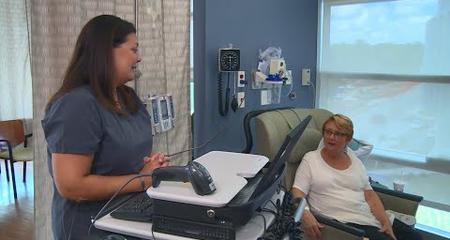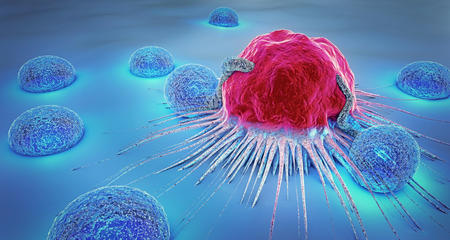
Almost all cases of cervical cancer are caused by the human papillomavirus (HPV). More than 80 percent of American women are infected with HPV at some point in their lives. The majority of individuals clear the virus from their systems with no apparent ill effects, and very few women develop cervical cancer.
Risk Factors
- Early age of intercourse
- Multiple sexual partners
- Immunosuppression
- Cigarette or cigar smoking
Screening
There are effective screening methods for finding abnormalities that should be assessed for cervical cancer in women, including the PAP test and the HPV test. Due to personal health history, some women may need to have a different screening schedule for cervical cancer. There may be variations to the test recommendations below depending on individual circumstances. All women who have been vaccinated against HPV (human papillomavirus) should continue to follow screening recommendations for their age groups.
According to the American Cancer Society, those aged 25 to 65 should have a primary HPV test* every five years. If primary HPV testing is not available, screening may be done with a co-test that combines an HPV test with a PAP test every 5 years or a PAP test alone every three years.
(*A primary HPV test is an HPV test that is done by itself for screening. The FDA has approved certain tests to be primary HPV tests.)
Please call 414-777-7700 to make an appointment for cervical cancer screening.
Prevention
- Vaccination: Gardasil and Cervarix.
- Protection against high risk strains of HPV which are linked to cervical cancer
- Protection against low risk strains which are linked to genital warts
- The Centers for Disease Control website offers information on HPV prevention and vaccines
- Condom use to protect against HPV, which is transmitted by sexual contact
- Smoking cessation
Pre-Cancerous Changes
Persistent HPV infection can eventually cause pre-cancerous changes to cells on the surface or in the canal of the cervix. These precancerous changes are called dysplasia (or disordered growth).
The diagnosis of dysplasia is made by undergoing a colposcopy — an advanced visual exam of the cervix and biopsy. Treatment of dysplasia depends on the degree of dysplasia.
Cervical dysplasia, a precancerous condition of the cervix, is grouped into three categories:
- CIN I (mild to moderate dysplasia)
- CIN II (moderate to severe dysplasia)
- CIN III (severe dysplasia)
If the dysplasia is more advanced, cryosurgery, electrocauterization, laser ablation or a loop electrosurgical excision procedure (LEEP) can destroy the precancerous cells and prevent cervical cancer.
Janet Rader, MD, FACOG, Medical College of Wisconsin gynecologic oncologist and chair of the Department of Obstetrics and Gynecology, is currently researching why some women develop cervical cancer while others do not.
Symptoms
Sometimes symptoms do not develop until the cervical cancer is advanced. Symptoms of cervical cancer include:
- Vaginal bleeding
- Weight loss/loss of appetite
- Fatigue
- Pelvic, back or leg pain
- Leaking of urine or feces from the vagina
- A single swollen leg
Diagnosis
If cervical cancer is suspected, the physician will biopsy any suspicious lesions and submit them to the lab for analysis. Other possible tests include imaging studies, such as an X-Ray, PET-CT scan and MRI to assess the extent of the disease.
Treatment
The treatment of cervical cancer depends on stage at diagnosis, along with a patient’s age and general health. Because a variety of treatment options are available, physicians at Froedtert & the Medical College of Wisconsin work together to design individualized treatment plans.
- Clinical trials: As an academic medical center, Froedtert & the Medical College of Wisconsin offer patients the opportunity to participate in many clinical trials, which offer cutting edge treatment. Patients who are eligible for clinical trials have the opportunity to be treated with novel agents or with a treatment that is being studied, in combination with treatment that is the standard of care. Clinical trials may study new treatments with chemotherapy or radiation, or they may study quality of life issues.
- Radical hysterectomy: During a radical hysterectomy, a gynecologic oncologist removes the patient’s uterus (including the diseased cervix), top part of the vagina, and lymph nodes in the pelvic region. A radical hysterectomy may be performed laparoscopically, with or without the assistance of the da Vinci ® Robotic Surgical System or with an open incision (by laparotomy). The ovaries do not need to be removed for the treatment of cervical cancer.
- Brachytherapy (internal radiation therapy): Brachytherapy is radiation that is directed to a localized region, increasing the amount of radiation that attacks the disease and minimizing the amount of radiation to surrounding tissues. Brachytherapy allows precisely targeted treatment that may improve outcomes and decrease toxicity (side effects) from treatment.
- External radiation therapy: Image-guided external beam radiation can be used to treat cervical cancer. This therapy usually targets the primary tumor and the lymph nodes.
- Chemotherapy: Often, a combination of intravenous chemotherapy and radiation is prescribed for cervical cancer. Specially trained oncology nurses administer chemotherapy and work with patients to minimize and manage side effects.
Virtual Visits Are Available
Safe and convenient virtual visits by video let you get the care you need via a mobile device, tablet or computer wherever you are. We’ll gather your medical records for you and get our experts’ input so we can offer treatment options without an in-person visit. To schedule a virtual visit, call 1-866-680-0505.



